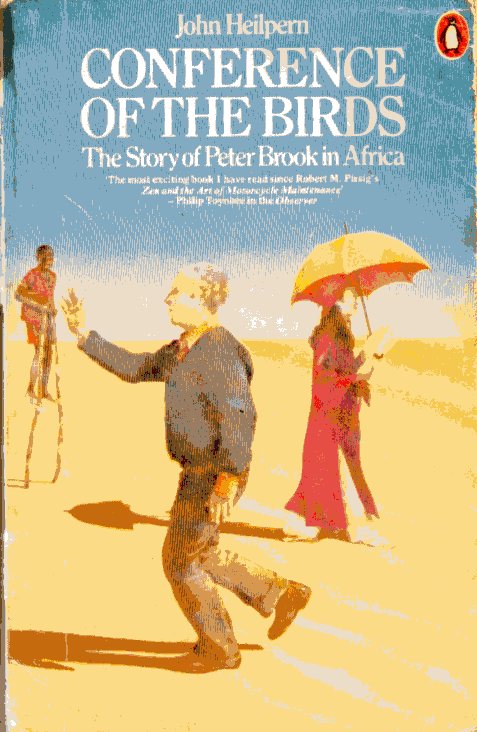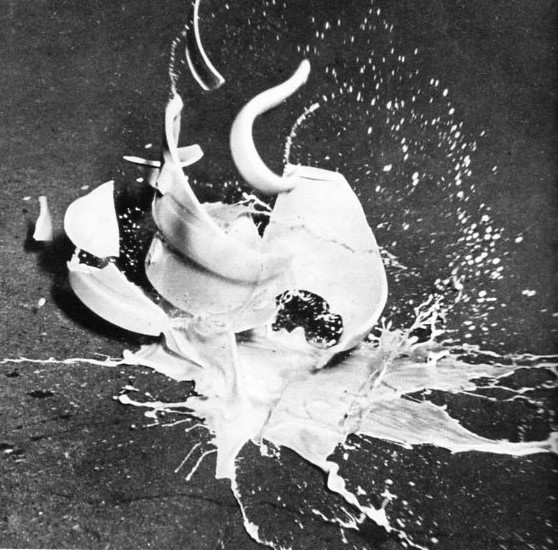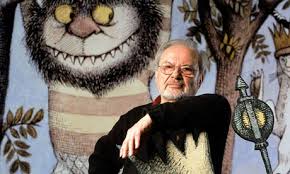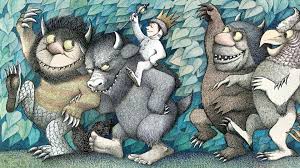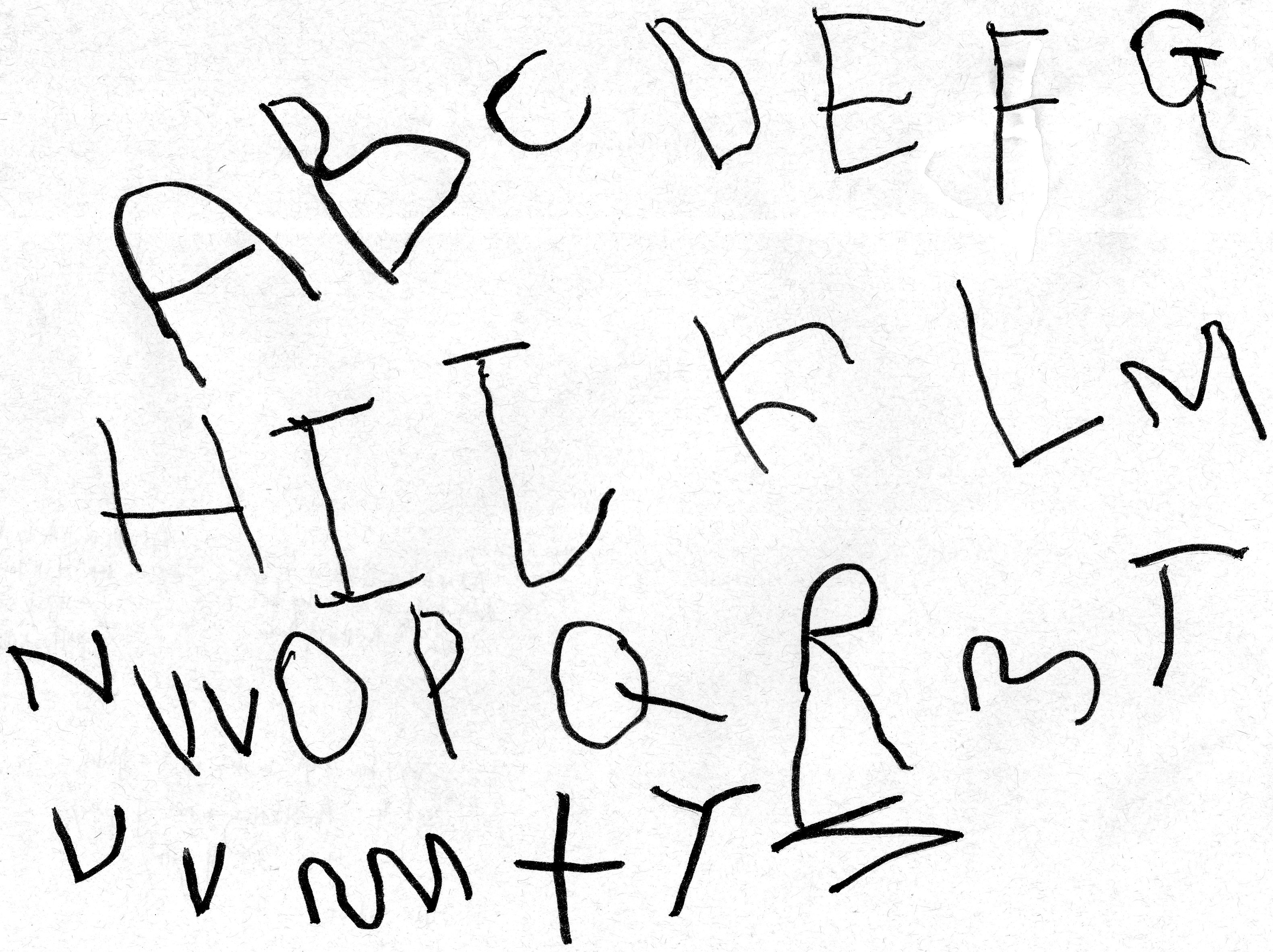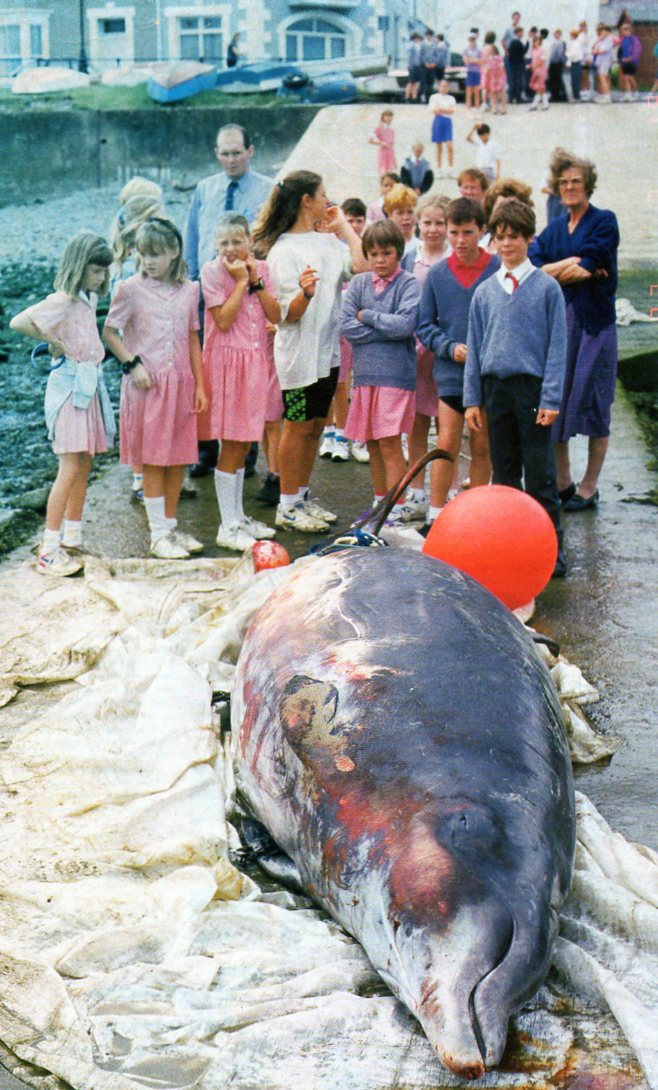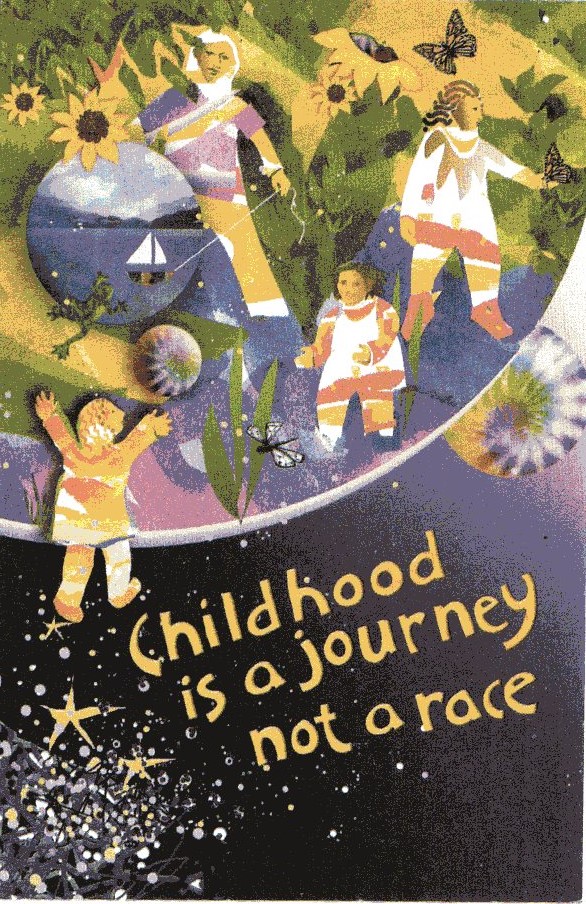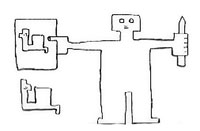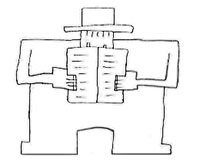TO END THE YEAR...
A thought from the British poet, Adrian Mitchell: “Poetry is a free country.”
THE CONFERENCE OF THE BIRDS
I’ve just re-read one of my favourite books – ‘The Conference of the Birds’ by John Heilpern. It’s a colourful and fascinating story, describing a journey through northern and western Africa made by British theatre director Peter Brook, with a troupe of actors, back in 1972/3.
John Heilpern has a great eye for detail and an infectious sort of curiosity about what goes on. The strange and talented mix of international actors are brilliantly brought to life, as are their many performances.
There’s some healthy scepticism. (By the third chapter, Heilpern has managed to tell us, “I like actors but sometimes they don’t know their arse from their elbow.”) And the writing is very funny. Nearly every chapter makes me laugh out loud, at something.
As well as enjoying the writing, I like the story. The book describes a journey in search of a theatrical experience which Peter Brook himself cannot easily define.
Along the way there are moments of magical inspiration, others of complete failure.
There’s a lot of plain, hard slog.
Everyone seems bewildered, at least some of the time. (At one point Heilpern says, “Nobody knew what they were there for or where they were going.”)
There are trials and errors, risks taken, flashes of good and bad luck, and completely unexpected moments of freedom and delight.
So, although it is all writ large (30 people travelling 8,500 miles through deserts, mountains and tropical forest) it feels as if Brook and his actors are journeying through the things that anyone following an artistic dream (with its madness, desperation and beauty) will end up experiencing.
I think that’s why the book grabbed me when I first read it, as a young man, curious about what it might mean to set off on an artistic journey. And it’s probably why it still grabs me some years later…when there’s no turning back!
AT LAST! A DISASTER!
You need something to go wrong, otherwise there would be no story.
The craft of writing stories involves many things and (usually) one is making things go wrong.
When things go wrong, questions hang in the air. Characters have to react. Suspense is created. Emotions are stirred. Things change.
In other words, the simple act of creating a problem, sets in progress many of the things that us humans (for whatever reasons) find most irresistible in stories.
I was at a children’s storytelling event a few months ago. Everything started off neatly and tidily. People were drinking juice and herb tea. A big rug was spread out. Someone was running a craft workshop. Most of the children were small. They were sitting on the rug, making small clay things. The activity was led by a woman who said encouraging, soothing things to the small children. And it wasn’t just her. Everyone was being rather smiley and nice.
There were a few children aged nearer 10 or 11. Among them was a boy who seemed pretty restless, and disappointed with what was going on.
Then someone dropped their tea cup.
It smashed loudly across the floor.
The boy grinned. His eyes lit up. He said, “AT LAST! A DISASTER!”
Nasruddin and the white donkey...
Nasruddin bought himself a new donkey. It was a very rare white donkey. Everyone admired it. Nasruddin loved it. Wherever he went, he went on his donkey.
Soon everyone knew about Nasruddin’s white donkey. They all agreed what a handsome donkey it was.
But it happened that a neighbour of Nasruddin’s was going to marry a girl in the next village. He wanted to arrive at his wedding in style. And he thought people would be very impressed if he showed up riding on a white donkey.
So he visited Nasruddin, to see if he could borrow the donkey.
Nasruddin didn’t much like the idea. The road to the next village wasn’t in good condition. He was worried that his beloved donkey would injure itself.
“What do you think, Nasruddin?” asked the neighbour. “Can I borrow the donkey?”
Nasruddin shook his head. “I’m sorry but it’s not here,” he said, “My son rode to the bazaar on it this morning. And he’s not back yet.”
Just at that moment, the donkey brayed loudly from the back of the house.
“It is here,” said the neighbour. “I just heard it.”
Nasruddin stared at the man. “What do you mean?” he asked.
“That sound just now. That was your donkey braying.”
“No it wasn’t,” said Nasruddin.
“It was,” his neighbour told him.
Nasruddin stared at the man for a moment. Then he asked, “Look. Who are you going to believe? Me or a donkey?”
ANA
A friend of mine in Brazil, Regina Machado, called and asked if I would tell some stories to a friend of hers – Ana – who was ill.
Ana has a small daughter. She used to give English classes based around art history. She was writing an MA thesis. Then, on the day she was due to present it, one of the assessors didn’t show up. The presentation had to be put back to a later date. That night, Ana suffered a massive stroke. The part of her brain which sends ‘motor’ messages to the rest of her body was wiped right out. All she can do now is blink her eyes.
I said yes. Regina took me there.
Ana was at her mother and father’s flat. It was full of beautiful paintings, clocks and artwork on the wall, though there was something a bit stuck about the place, as if everything had been in exactly the same position for decades.
Ana’s small daughter bustled about with scissors and toys. She showed me her room, overflowing with dolls, and told me their names.
I went down the corridor to the room where her mother lay, imprisoned in a paralysed body.
When you think what has been taken from Ana (the ability to speak, walk, feed herself, write, turn in her sleep, reach out a hand to comfort her daughter…) it makes most of problems we find ourselves struggling with seem very petty.
I told Ana some stories in English. Rain burst out of the sky behind us, down onto a world she cannot turn her head to see. I could tell she understood the stories well. A few times she made a slight, gurgling chuckle.
Regina said that after I left she cried and cried.
Writing secrets - A PEN AND A NOTEBOOK
People like asking writers, “Where do you get your ideas from?”
I usually say that there are ideas for stories or poems all around us. The only difference between writers and other people is that we make sure we’ve got a pen and a notebook to hand, so that when an idea comes we don’t let it go. We write it down.
There isn’t a notebook in my pocket one hundred percent of the time. (Anyway, the secret isn’t just having the notebook. There’s a way of looking and listening with a sort of curiosity, or alertness, or care that comes into it as well.) But, actually, there won’t be many occasions when I don’t have a pen and notebook somewhere to hand.
To the surprise (quite often annoyance) of people around me, I do start scribbling things at odd moments: when walking along a busy pavement…or watching a film at the cinema…or in the middle of the night…
And If you ask around, notebooks of story ideas, observations, memories, fragments of overheard language, and other descriptions and scribbles are the foundations on which very many writers build their work.
The German author and philosopher, Walter Benjamin included the following in his thirteen pieces of advice on the writer’s technique: “…keep your notebook as strictly as the authorities keep their register of aliens.”
I like spiral-bound notebooks. As I go along, I destroy them! I tear out the pages. I cut them up. I throw things out. Then (sometimes by typing them on to my computer, sometimes by putting them in actual files on shelves) I sift what I’ve written into a whole lot of different categories.
So instead of having piles of old notebooks, I’ve got strange files of bits of paper.
One file has names for characters in it. Another is full of bits and pieces of dialogue. Another holds ideas for story titles.
And those are the predictable ones. If I look through, I’ve also got a file containing names of dog breeds. Another contains names of breakfast cereals. And one’s labeled COWBOY LANGUAGE,
If a hurricane ever hits my writing studio, a lot of strange confetti is going to fly!
A SHEEP'S HEAD
The other day, I was walking past a counter in a supermarket and I heard a customer ask the man who was serving, “Do you have a sheep’s head?”.
The man behind the counter gave a shrug and said, “No…I think it’s just my hairstyle.”
ERGO
My wife makes animated films. Because of her, I quite often find myself at an animation festival or in a cinema…watching some strange and beautiful new film dreamed up by an animator somewhere in the world.
That’s my luck!
Like puppet theatre and poetry, I think of animation as one of the art forms that can genuinely come close to making magic.
Over the years, animated films I’ve seen have sparked all sorts of ideas that have fed into my writing.
Here’s one – a twelve-minute-long film by Hungarian director Géza M Tóth. I saw it five years ago at the Anima Mundi festival in Sao Paulo.
It has stuck in my mind!
http://www.dailymotion.com/video/xdlymg_ergo-dir-geza-m-toth_shortfilms
INSPIRATION…Maurice Sendak
If you ask me, the picture book was one of the very best artistic forms to evolve in the 20th century. It’s up there with the three-and-a-half-minute rhythm and blues song, the animated film, the television drama series, or any other remarkable creative innovation you can think of that came out of the same period.
There were illustrated books for children long before 1900. But something seemed to happen around the time of the first commercial edition of Beatrix Potter’s ‘Peter Rabbit’, in 1902.
A taste developed for short, affordable, colour-illustrated storybooks for younger children. And in the decades that followed, the illustrations in these books became ever less decorative, ever more a part of the storytelling. So, sometimes step by step, sometimes in leaps forward, the special form of the picture book that we know today came to be.
It’s a special form because it’s such a mix of delights. Inside good contemporary picture books you get characters that children love from the opening words…engaging themes…page-turning stories…inventive, skilfully-crafted illustrations…flights of imagination…colour…humour…emotion and – as if all that wasn’t enough – endings which uplift, provoke, surprise (or do all three!)
That’s a lot of delight for an adult reader and child to share – all packed into 12 (or so) double-page spreads.
And it would be wrong to speak only of delight. There’s a notable history of picture books going into uncomfortable, shadowy subjects too. And for that aspect of picture-book making, I’d say we should raise our hats to the American author and illustrator, Maurice Sendak.
Sendak was a fiercely independent, honest, funny, questioning character. (Have a watch of this short film, capturing him at home, in his later years. You’ll see what I mean…)
http://www.youtube.com/watch?v=xXAjkLUv7dY
He wasn’t the only one to push back boundaries around what can be in a story for 2 to 6 year-olds. But his picture book, “Where the Wild Things Are” was such a brilliant challenge to the conventions of its day, and became so popular, that it ended up paving a good bit of the way for other challenging picture books that have followed.
The story of Max (the protagonist of ‘Where The Wild Things Are’) is a simple one. It’s a tale of leaving and returning. It’s only 338 words long. But over that short distance, Sendak touches on a many difficult themes: cruelty, uncontrolled anger, punishment, loneliness, ecstatic release and fear (among others.) The ‘wild things’ themselves are wonderfully complex. (Are they going to be friends with Max, or are they going to eat him up?) It makes for one of the most fantastic journeys in all of children’s literature.
And it’s telling that, despite being one of the best known children’s book makers of his generation, Maurice Sendak didn’t like to be described as a children’s author.
He broke the mould with his picture books. He went searching for truths about what it is to be human, whether you’re a child, a grown-up, or somewhere in between. In other words, he approached picture-book making with the sharpness of a genuine artist’s sensibility.
And it has been a wonderful thing for children’s literature that this sensibility found its way into the making of books for very young children.
Picture books could have evolved into pretty, soothing boxes of delight to help parents get children to sleep. Thanks to the likes of Maurice Sendak, they are a much more exciting and wild prospect.
FROM SIDE TO SIDE
A long time ago, I met a Zimbabwean film maker who had travelled from his country and was living in England.
We were talking about the differences between his country and mine: differences between the way people live and work and talk…differences in the attitude towards time…
And the man told me this story.
“After a couple of years of living in England, I went back home to visit my family members in Zimbabwe. My grandmother was watching me when I got back. And, after a day or two, she said to me, ‘You’ve come back different. You’ve come back looking straight ahead. Please, don’t forget to look from side to side as well. You see the most interesting things when you look from side to side!”
Four quotations about COMEDY
American author, Mark Twain: “The human race has only one really effective weapon and that is laughter.”
British writer and comedian, Barry Cryer: “Analysing comedy is like dissecting a frog. Nobody laughs and the frog dies.”
British actor, Peter Ustinov: “Comedy is simply a funny way of being serious.”
American film director, Woody Allen: “I’m thankful for laughter, except when milk comes out of my nose.”
What do you think?
A friend of mine in Brazil left the hectic megacity of São Paulo in the 1970’s to live a quieter life, a thousand miles or so to the north west, in the state of Mato Grosso.
While there, he got to know some native Brazilians of the Xavante people. And he brought one of them – a young man called Rubens – with him on a visit to São Paulo.
Rubens had never seen a large town before, let alone a city on the scale of São Paulo. So, before anything else, my friend took him to the top of a downtown skyscraper where he could take a proper look at the place.
The young Xavante took his time, staring out at the city, which stretches off as far as the eye can see.
He didn’t say anything. He walked across to the other side of the building.
There he looked down at the same urban scene, sprawling in the opposite direction.
Still he didn’t say a word.
So my friend asked, “O que que você acha?” (“What do you think?”)
Rubens replied, “Não vai dar certo.” (“It’ll never work out.”)
THE ADVENTURE OF WRITING
I came across this a couple of days ago…
It was written by my elder son, Joey. It was his first try at writing the alphabet.
Joey was four at the time. I was sitting nearby at the table, as he wrote it. And what I remember was the excitement that radiated from him as he worked at the task. It was a tricky but exhilarating journey, into a mysterious place he’d never been to before.
Remembering the mood it put him in, I’m left feeling that, when encouraging beginner writers, we should do everything possible to feed (and keep alive) the sense of excitement and adventure which comes from setting out on the journey into writing.
I may be a few years further down the line than Joey, but I’m still on that same writing journey myself.
And that sets me thinking us older writers, too, should do everything we can to keep alive the feeling of excitement and adventure…as (like Joey) we take our tricky routes into mysterious places we’ve never been to before.
Three quotations about WRITING AND PASSION
American science-fiction author, Melissa Scott: “Writing isn’t generally a lucrative source of income; only a few, exceptional writers reach the income levels associated with the best-sellers. Rather, most of us write because we can make a modest living, or even supplement our day jobs, doing something about which we feel passionately. Even at the worst of times, when nothing goes right, when the prose is clumsy and the ideas feel stale, at least we’re doing something that we genuinely love. There’s no other reason to work this hard, except that love.”
American novelist, Judy Blume: “The only thing that works with writing is that you care so passionately about it yourself, that you make someone else care passionately about it.”
Russian and Soviet poet, Marina Tsvetayeva, “If I were taken beyond the ocean into paradise and forbidden to write, I would refuse the ocean and paradise.”
A PICTURE THAT TELLS A STORY
I came across this a few years ago. in the BBC’s Wildlife magazine. Some school-children in Scotland and a dead dolphin…
What's the difference between a story and a lie?
This comes from a book published in 1984, by the American author Paula Fox, called ‘The Servant’s Tale’:
“What’s the difference between a story and a lie?” I asked.
“A lie hides the truth, a story tries to find it,” Nana said, impatiently.
I strained to grasp her meaning.
“Don’t worry,” she said soothingly. “You’ll see it all some day.”
I understood enough to know that Nana saw what others couldn’t see: that, for her, the meaning of one thing could also be the meaning of a greater thing.
INSPIRATION...Seamus Heaney
I was sad to hear that the poet Seamus Heaney died today.
I’ve long loved the mix with which he wrote…of sharp-eyed observation, challenging thinking, musical language and an almost startling awareness of the weight of each word.
He and his friend Ted Hughes were the two elder poets working in my corner of the world as I made first, clumsy attempts at writing poetry in my teens.
When it came out, in 1982, my father gave me their anthology ‘The Rattle Bag’, as a Christmas present. I was seventeen. It was quite some present – an amazing, travelling collection of poetry.
I can remember feeling new things going on inside me as I turned the pages of that book…trying to keep up with the new words, the unfamiliar names, and the range of poetic styles from all round the world and all across the centuries.
It was one of the moments when a cultural object seemed to burst open something in my young mind.
It had happened three or four years earlier when I put on the first album by the punk band Stiff Little Fingers, and dropped down into the fierce, dark guitars of the opening song.
I remember seeing Joan Miró’s strange, blue work ‘Painting’ at the old Tate Gallery as a teenager. And the world suddenly seemed bigger and bolder than I had thought.
Similar things went on as I stared my way through a season of Luis Buñuel films that was on the television around then.
I even remember a building having the same effect – the first time I looked up at the glass and bright-coloured tubes of the Centre Georges Pompidou in Paris, aged 16.
What was bursting? Horizons? New doorways? The innocence of someone yet to leave home? I’m not sure how to put it. All I can say is that each time it felt like something opening that wasn’t going to close.
I heard Seamus Heaney reading his poems, at the Edinburgh Book Festival in 2002. I remember him being refreshingly bumbling (coming on the stage with his poems in a tatty old bag) and, with it, serene and tuneful.
He read with passion and care. The most beautiful poem of the night was ‘At The Wellhead’, in which he describes his wife’s shut-eyed singing and talks of Rosie Keenan, a blind, musical neighbour in the farming community where he grew up, who opened his young mind to the possibilities of music and poetry.
At the end there were questions for him and someone asked, “How did you become a poet?” Seamus Heaney replied, “It’s a mystery to me, happily. At school I wasn’t good at English. I was good at sums.” Then he added that there were ways in which maths still felt central. He tried to remember the mathematical formula for work. Someone in the audience helped him: WORK = FORCE + DISTANCE.
“Yes,” said Heaney, with sudden passion. “And it’s the distance that’s so important. It’s no good if you just dump it down. Move it!”
POSTSCRIPT
And some time make the time to drive out west
Into County Clare, along the Flaggy Shore
In September or October, when the wind
And the light are working off each other
So that the ocean on one side is wild
With foam and glitter, and inland among stones
The surface of a slate-grey lake is lit
By the earthed lightning of a flock of swans,
Their feathers roughed and ruffling, white on white,
Their fully grown, headstrong-looking heads
Tucked or cresting or busy underwater.
Useless to think you’ll park and capture it
More thoroughly. You are neither here nor there,
A hurry through which known and strange things pass
As big soft buffetings come at the car sideways
And find the heart unlatched and blow it open.
by Seamus Heaney (from ‘The Spirit Level’, 1996)
LOVE OF LEARNING
Three quotations about STORIES
Jewish-American author, Isaac Bashevis Singer: “When a day passes it is no longer there. What remains of it? Nothing more than a story. If stories weren’t written, men would live like beasts, only for the day…”
British art critic and novelist, John Berger: “Stories are always taking things from one place to another.”
Nigerian author, Ben Okri: “Without fighting, stories have won over more people than all the great wars put together.”
OF COURSE
A few weeks ago, I performed in a ‘storytelling marathon’ in São Paulo. A Brazilian storyteller called Dani Barros told this story. She heard it while travelling in Burkina Faso and Mali…
There was once a path which led through a forest. At the end of this path was a village, and the village was famous for a particular reason. People said that whoever went there was changed in some way.
It was a long way to the village. The path wound through the forest for many miles. And about halfway along it, there was a house where a widow lived with her son. This was good news for travellers on their way to the village. Many of them would break their journey at the widow’s house, and sleep there for a night.
That’s exactly what happened one day. A stranger came walking along the path and, when he reached the house, the widow went out to greet him. “It’s a long way to the village,” she said. “Perhaps you’d like to spend a night with me and my son.”
The stranger accepted. The next day, he carried on his journey.
Several weeks went by. Then the traveller came back. “How did you like the village?” asked the widow.
“I was disappointed,” the man said to her. “I thought it was going to be special in some way. But it’s just a village in the middle of a forest. The people have very little. Nothing interesting seems to happen. So I decided to leave the place.”
“Of course,” said the widow, and the traveller went on his way.
Only a few days later, another stranger came walking along the path, and the same thing happened. When he reached the house, the widow went out to greet him. “It’s a long way to the village,” she said. “Perhaps you’d like to spend a night here.”
The stranger accepted. He spent a night with the widow and her son. Then, the next day, he continued his journey.
Several weeks later, the stranger came back. “How did you like the village?” asked the widow.
“It was the most beautiful place I have ever seen,” he told her. “I couldn’t believe how colourful the flowers are and how tall the trees grow. Children run around freely, and the older ones look after the younger ones. Every night the villagers gather together to dance and tell stories. I felt so happy there, I’ve decided to go and fetch what I own, and go back to live there!”
“Of course,” said the widow, and the traveller went on his way.
When he’d gone the widow’s son said to her. “I don’t understand. One traveller came back and he told you he didn’t like the village, and you said, ‘Of course.’ Then the next traveller came back and told you he loved everything about the place, and you said exactly the same thing!”
His mother replied, “Well, that’s because everyone sees the world according to what they have in their heart.”
And the boy said, “Of course.”
Writing secrets - FLYING CROOKED
I’ve been working on a second novel for teenagers. It’s a tough piece of writing (for reasons that will become apparent if ever I get to the end of it and it becomes a book.)
Recently there have been some days when I’ve flown along, covering lots of pages. But there have been plenty of other days when I expected to fly along, covering lots of pages, and actually found myself spending long hours on a single paragraph, or getting nowhere at all.
There’s an Oscar Wilde story I like. He said he spent an entire morning working on a poem, and all he did was put in one comma. Then he worked on the poem all through the afternoon, and all he did was take the comma out.
Oscar Wilde liked to exaggerate, for comic effect. But I find this story of his completely believable! Writing gets like that.
Some years ago, the difficulty…the stops and starts…and the getting-nowhere in spite of all the trying might have left me feeling dejected…perhaps pessimistic about what I was doing…probably frustrated with myself.
But I’ve been writing books for long enough now, to know that the bad days are intimately connected with the good days. You can’t afford to puff yourself up when it’s going well, or deflate when it’s going badly.
I’ve talked about this with my friend, the painter, Ed Gray. He’s described going through exactly the same good times and bad times when working on paintings in his studio. And he has a good little saying to deal with it: “The important thing is to show up.”
Sometimes I can ask myself if I’ve “shown up” for my work in recent days, and the answer is, “No.”
If I look back on recent weeks, the answer is “Yes.” And when that’s the case, I find myself feeling quite optimistic about the slowness, and the detours and difficulties along the way.
This poem, by British writer Robert Graves, has become a favourite:
FLYING CROOKED
The butterfly, a cabbage-white,
(His honest idiocy of flight)
Will never now, it is too late,
Master the art of flying straight,
He has–who knows so well as I?–
A just sense of how not to fly:
He lurches here and here by guess
And God and hope and hopelessness.
Even the aerobatic swift
Has not his flying-crooked gift.
Robert Graves (1895-1985)

